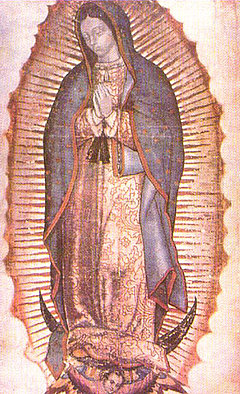
Miracles are possible because God upholds and sustains his creation into being. The doctrine of belief about creation affirms that creation is "in a state of journeying" (CCC 301-308). This dogma of creation is not opposed to science, as explained in the articles below.
Like the Shroud of Turin, the image of Guadalupe has been subjected to rigorous scientific testing, the results of which are astonishing.
The sign given on the tilma (the cloak fabric of seer Saint Juan Diego) was like a photo book for the Indians, the work of a heart full of love, showing that Mary deeply understands the language of those she interacts with.
It is also a poignant message to the proud of today, who like to label religious subjects as unscientific.
First of all, the image of Mary is printed on Juan Diego’s garment, a tilma, which that would normally last about 20 years at the most. In this case it has remained intact for 5 centuries, resisting acid, insects, humidity, the blast of a bomb, fire, and more. Doesn’t this miraculous resistance point to the presence of God, the Creator who upholds his creation into being? Doesn’t this incredible resistance speak to us about Mary’s enduring love?
Secondly, the cloak’s embroidery work contains a quincunce (four petals around a circle). The large flowery ones are an Aztec symbol for a hill, a decorative pattern well-documented in the 16th century pre-Hispanic manuscript books. This detail shows the loving and friendly heart of Mary who is deeply interested in the customs of those she visits.
Next, the apparition reveals Christ, since Mary is pregnant with him and carries a small cross. By this she redirects the Aztec intuition of redeeming sacrifice, towards Christ.
Another particularity of the image is the color of the face and hands of Mary, whose shades vary depending on how close you look at it. Her mixed-race features seem to embrace both the native and the Spanish heritages. In fact, national unity in Mexico was achieved quickly thereafter. Mary is the Mother of Unity.
Mary’s eyes have depth and shine, with the reflective property of living eyes. Most astonishing is the fact that in her eyes one can observe the reflections of several people: Juan Diego, a family, and a bishop, plus a partially visible piece of furniture and the curve of the ceiling. All this suggests an incredible love for a particular people. Mary’s focus is not on anonymous crowds but on real individuals, and each one is imprinted in her eyes!
The image has no base layer and no brushstroke. The fabric simply acted as a photographic film. The pigments are of completely unknown origin, there is no cracking, and the blue is as bright as if it had been freshly applied. Doesn’t all this suggest a supernatural work of Art? Doesn’t this represent a gift from Mary to modern times, to encourage belief in the supernatural conception of Jesus through the Holy Spirit?
The stars on the cloak reflect the exact position of the constellations on the morning of December 12, 1531, as a projection (with a left/right inversion). Among others we can see the constellation of the lion, known in the Aztec language as Nahui Ollin, i.e “center of time and space”! And the most important star in this constellation, the star we call Regulus (literally "little king"), rests on Mary's belly! Mary, Mother of the Son of David, Mother of Jesus king of kings, who is at the center of time and space, Mary Mother of God!
By Françoise Breynaert